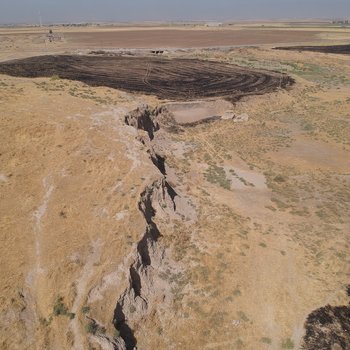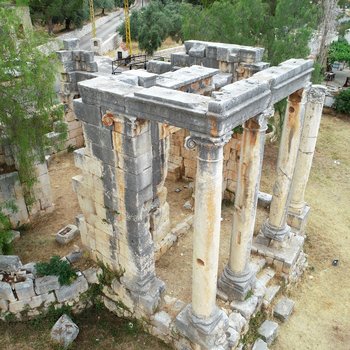Marco Iamoni
DIUM

Io sono soltanto un gatto, però ogni tanto rifletto. Non c’è niente di più comodo che fare il professore. Se mai rinasco uomo, diventerò professore, è deciso. Un lavoro che permette di dedicare tanto tempo al sonno, chiunque è in grado di svolgerlo, anche un gatto.
N. Soseki

Marco Iamoni
Archeologia e storia dell'arte dell'Asia occidentale e del Mediterraneo orientale antichi (STAA-01/E)
- Professore associato
- Tel: 0432 556179
- Email: marco.iamoni@uniud.it
- Studio: Palazzo Caiselli, second floor, room L2-10
- Insegnamenti: Archaeology of the Levant and the Ancient Near East; History of the Ancient Near East; Archaeology of Inequalities
Marco Iamoni
Archeologia e storia dell'arte dell'Asia occidentale e del Mediterraneo orientale antichi (STAA-01/E)
- Professore associato
- Tel: 0432 556179
- Email: marco.iamoni@uniud.it
- Studio: Palazzo Caiselli, second floor, room L2-10
- Insegnamenti: Archaeology of the Levant and the Ancient Near East; History of the Ancient Near East; Archaeology of Inequalities


Io sono soltanto un gatto, però ogni tanto rifletto. Non c’è niente di più comodo che fare il professore. Se mai rinasco uomo, diventerò professore, è deciso. Un lavoro che permette di dedicare tanto tempo al sonno, chiunque è in grado di svolgerlo, anche un gatto.
N. Soseki
I graduated in Classical Literature at the University of Verona, after which I continued my studies abroad specializing in Archeology of the ancient Near East at the University of Cambridge, where I obtained the title of research doctor with a thesis on Late Bronze ceramics from the Qatna site. After the doctorate I continued studying the ceramic tradition by expanding the body of data and inserting it in the Middle Bronze. I published the results of this work in a monograph illustrating the technological changes that characterize vascular production during the II millennium at the Qatna site and more generally in western Syria / northern Levant, explaining how these are also a reflection of social changes and politicians who crossed the site of Qatna between the eighteenth and fourteenth centuries BC.
In 2013 I became an TD type A researcher and, thanks to the participation as deputy director in the Regional Archaeological Land of Nineveh directed by Professor Morandi, I opened a new research topic focused on the study of settlement patterns in Northern Mesopotamia during the Neolithic ceramic and the Chalcolithic (VII – IV millennium BC).
From December 2018 I have held the position of TD type B researcher at the DIUM, taking courses in History of the Ancient Near East, Archeology of the Mediterranean and the Near East and organizing seminars on ceramics. In 2022 I became associate professor.
I have been working continuously in the Middle East since 1999, particularly in Syria, where I was a member and deputy director of the Udine mission in Qatna. I have also worked with other missions in Syria (Palmira, Tell Brak and Tell Ahmar), in Oman (Salut) and in Iraqi Kurdistan/Iraq; this allowed me to broaden my scientific training by investigating different aspects of near-eastern archeology linked to the study of material culture, the landscape of settlements and the socio-economic traits that characterize the world of the Ancient Near East.
I continue to study in particular my two main research branches (the Levant during the Bronze Age and Northern Mesopotamia in the pre- and protohistoric age) with two field research projects. The first is a research that I jointly direct with the Lebanese University - Third Branch of Tripoli and the Lebanese Antiquities Directorate, whose purpose is to reconstruct the development of the settlement organization in the area of Koura, in Northern Lebanon. We have already carried out 3 campaigns identifying several archaeological sites, many of which until now were completely unknown.
The second is a joint excavation with the Directorate of Antiquities of Dohuk in Iraqi Kurdistan/Iraq at the Asingeran site, an important town from the 7th and 4th millennium BC, with important occupation phases dating back to the II and I millennium BC. With this excavation we intend to research the fundamental transition from village to city in Mesopotamia and help to understand one of the most important phenomena for Near East archeology and the history of ancient societies.
Pubblicazioni
Asia, Southwest: Neolithic Onset of Modern Societies
in: E. Nikita, T. Rehren (curr.), Encyclopedia of Archaeology. Second Edition, Amsterdam 2023 (con J.S. Baldi)
Asingeran: A Case of Micro-Complexity in the Navkur Plain? Data from the Second Archaeological Season of the Joint Italian-Kurdish Research Campaign
ZOA 15 (2022) 20–66 (con R. Valente, M. Scattini, B.J. Hasan)
Multispectral and High-Resolution Images as Sources for Archaeological Surveys. New Data, from Iraqi Kurdistan
Archeologia e Calcolatori 34/2 (2023) 207–23 (con R. Valente e E. Maset)
Late Chalcolithic Northern Mesopotamia in Context. Papers from the Workshop Held at the 11th ICAANE in Munich, April 5th 2018
a cura di J.S. Baldi, M. Iamoni, L. Peyronel e P. Sconzo, Turnhout 2022.
Trajectories of complexity. Socio-economic Dynamics in Upper Mesopotamia in the Neolithic and Chalcolithic Periods
a cura di M. Iamoni, Wiesbaden 2016
The Land of Nineveh Archaeological Project: The Ceramic Repertoire from the Early Pottery Neolithic to the Sasanian Period
BASOR 375 (2016) 119–169 (con K. Gavagnin, R. Palermo)
Landscape and settlement in the eastern Upper Iraqi Tigris and Navkur plains: the Land of Nineveh Archaeological Project, seasons 2012-13
Iraq 77 (2015) 9–39 (con D. Morandi Bonacossi)
A vital resource in prehistory: Water and settlement during the Pottery Neolithic and Chalcolithic periods. A preliminary analysis of the Eastern Upper Tigris basin area
in: H. Kühne (cur.) Water for Assyria. Studia Chaburensia 7. Wiesbaden 2018, 7–24
A New Palatial Ware or a Case of Imitation of Egyptian Pottery? The Brownish Red Slip (BRS) from Qatna and Its Significance within the Northern Levantine Ceramic Tradition of the Mid-Second Millennium BC
in: Y. Heffron, A. Stone, M. Worthington (curr.) At the Dawn of History: Ancient Near Eastern Studies in Honour of J. N. Postgate, Cambridge 2017, 217–237
Larger site, better life? Site dimensions and the path to socio-economic complexity in Upper Mesopotamia across the Halaf and Ubaid periods
in: M. Iamoni (cur.) Trajectories of complexity. Socio-economic Dynamics in Upper Mesopotamia in the Neolithic and Chalcolithic Periods. Studia Chaburensia 6. Wiesbaden 2016, 57–84








